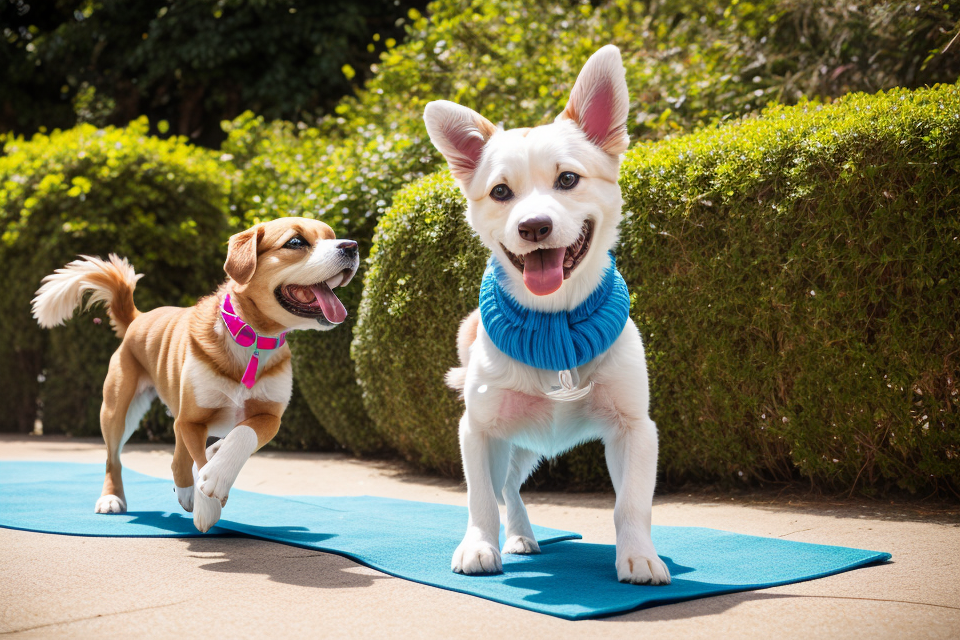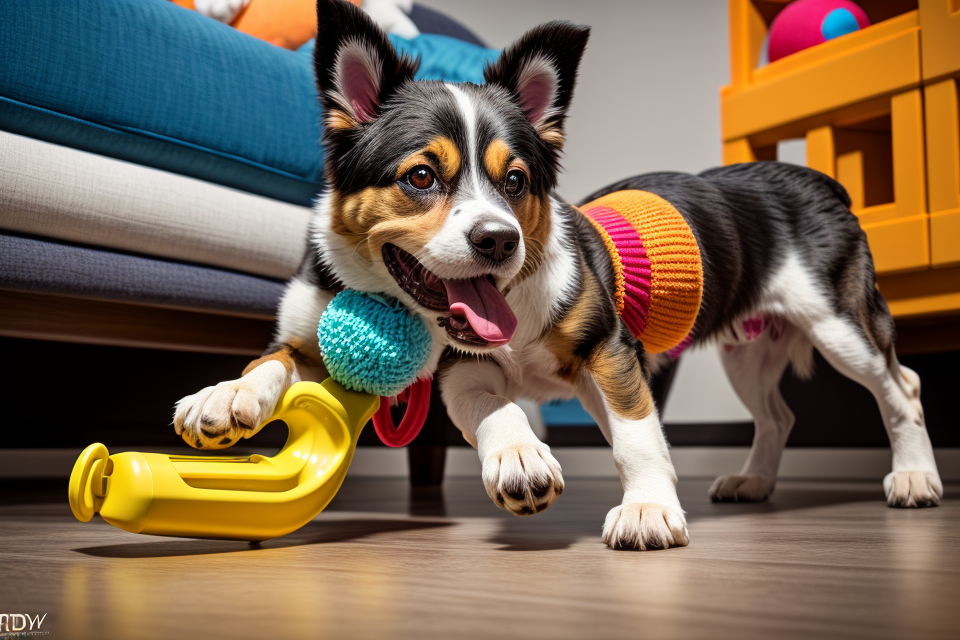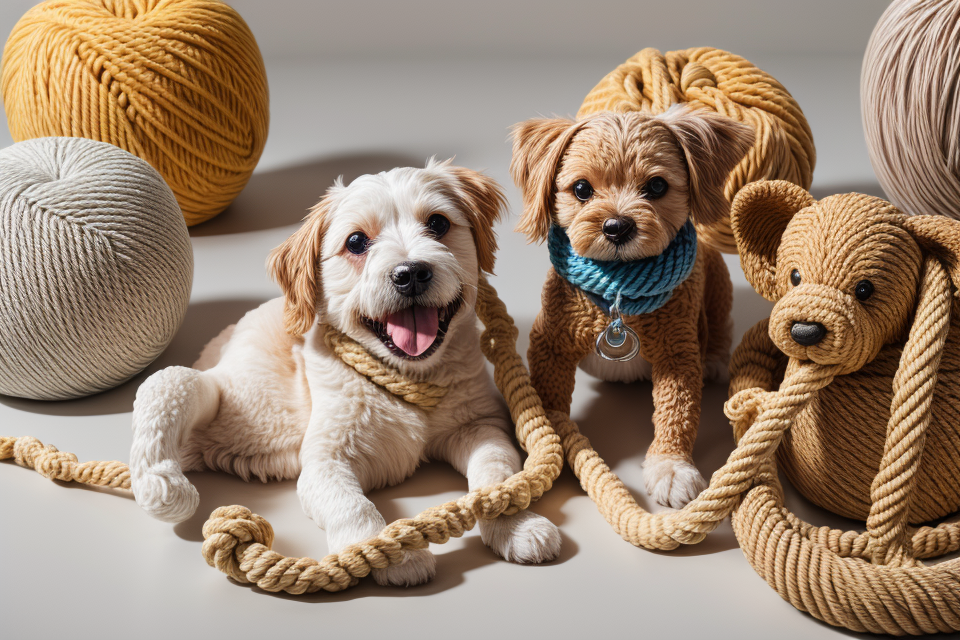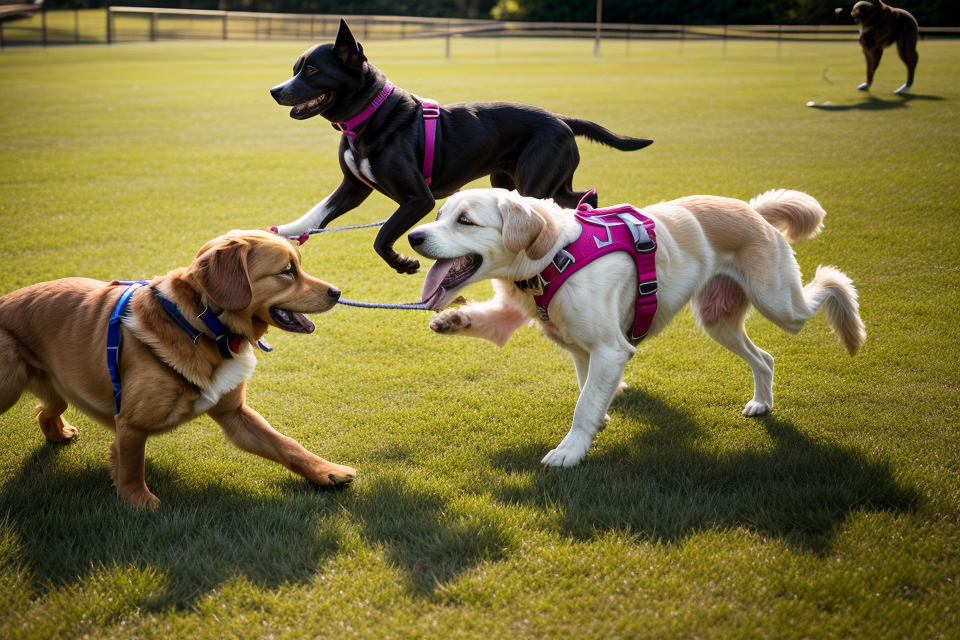Are you looking for a fun and engaging way to play with your dog? Tug toys are a great option! Not only do they provide endless entertainment for your furry friend, but they also offer numerous benefits for their physical and mental health. However, to maximize the benefits of tug toys, it’s important to use them properly. In this guide, we’ll show you how to use a tug toy to provide your dog with hours of fun and exercise, while also strengthening your bond. So, let’s get started and learn how to make the most out of tug toys!
What are Tug Toys?
Definition and Purpose
Tug toys are a type of dog toy designed for interactive play between dogs and their owners or trainers. They are typically made of durable materials, such as rope or nylon, and are often designed with a handle or loop for easy manipulation. The purpose of tug toys is to provide dogs with mental and physical stimulation, improve their problem-solving skills, and strengthen the bond between dog and owner.
In addition to providing exercise and entertainment for dogs, tug toys can also be used as a tool for training and obedience. By teaching a dog to drop a tug toy on command, owners can reinforce good behavior and build trust between themselves and their pets.
Overall, tug toys are an essential part of a well-rounded dog playtime routine, providing both physical and mental stimulation for dogs of all ages and sizes.
Types of Tug Toys
When it comes to tug toys, there are several types available in the market, each with its own unique set of benefits and drawbacks. Understanding the different types of tug toys can help you make an informed decision when choosing the right toy for your dog. Here are some of the most common types of tug toys:
- Fabric Tug Toys: These are perhaps the most popular type of tug toys, made from materials such as nylon, cotton, or fleece. They are often soft and flexible, making them gentle on your dog’s mouth and teeth. They come in a variety of shapes, sizes, and colors, and can be easily filled with treats or toys for added fun. However, they do require more maintenance than other types of tug toys, as they need to be washed regularly to prevent the growth of bacteria.
- Rope Tug Toys: Rope tug toys are made from thick, durable rope and are perfect for powerful chewers. They are long-lasting and can withstand a lot of biting and tugging. Rope tug toys are also easy to clean and drain quickly, making them a good option for dogs who like to play in the water. However, they can be more difficult to grip than fabric tug toys, and may not be suitable for smaller dogs.
- Rubber Tug Toys: Rubber tug toys are made from a type of synthetic rubber and are designed to be durable and flexible. They are resistant to tearing and biting, making them ideal for dogs who like to play rough. They are also easy to clean and drain quickly, but may not be as soft on your dog’s mouth and teeth as fabric tug toys.
By understanding the pros and cons of each type of tug toy, you can make an informed decision about which one is best for your dog’s needs and preferences. Whether you choose a fabric, rope, or rubber tug toy, the key is to provide your dog with a fun and engaging toy that promotes healthy play and exercise.
How to Choose the Right Tug Toy for Your Dog
Factors to Consider
When choosing the right tug toy for your dog, there are several factors to consider to ensure that you get the best value for your money and that your dog gets the most benefits from the toy.
- Size and weight of the dog: The size and weight of your dog should be a significant factor in choosing the right tug toy. Smaller dogs may not be able to handle large and heavy tug toys, while larger dogs may find small and lightweight tug toys to be uninteresting. It’s essential to choose a tug toy that is appropriate for your dog’s size and strength to prevent injuries and ensure that they get the most enjoyment out of the toy.
- Durability and strength of the tug toy: A durable and strong tug toy will last longer and withstand the rough play of your dog. Look for tug toys made from high-quality materials that can withstand the wear and tear of regular use. Avoid purchasing tug toys that are flimsy or easily damaged, as they will not provide your dog with the benefits of playing with a tug toy for long.
- Cost and affordability: While it’s essential to choose a high-quality tug toy for your dog, it’s also important to consider your budget. Set a budget for yourself and look for tug toys that offer the best value for your money. You can find high-quality tug toys at various price points, so don’t sacrifice quality for affordability. However, if you’re on a tight budget, you can also consider purchasing a tug toy that is slightly cheaper but still offers durability and longevity.
Recommended Tug Toys for Different Dog Breeds
Choosing the right tug toy for your dog is crucial to ensuring a fun and safe playtime experience. Different dog breeds have different needs and preferences when it comes to tug toys, and selecting the right one can make all the difference. Here are some recommended tug toys for different dog breeds:
Small dogs
Small dogs such as Chihuahuas, Terriers, and Poodles, tend to prefer tug toys that are lightweight and easy to carry. Some good options include:
- Soft plush toys with ropes or handles
- Mini rope toys
- Finger puppets or small stuffed animals
These types of tug toys are perfect for small dogs because they are easy to grasp and can be played with both alone or with a human partner.
Medium dogs
Medium dogs such as Labs, Golden Retrievers, and Boxers, typically have a bit more strength and can handle a bit more weight. Some good options for medium dogs include:
- Soft plush toys with handles
- Rope toys with a bit more weight
- Rubber toys with a squeaker inside
These types of tug toys are perfect for medium dogs because they are sturdy enough to withstand some tugging, but still soft enough to be gentle on their mouths.
Large dogs
Large dogs such as German Shepherds, Rottweilers, and Great Danes, require tug toys that can withstand their strength and size. Some good options for large dogs include:
- Tug toys made of heavy-duty materials such as nylon or rope
- Large plush toys with handles
- Hard rubber toys with a squeaker inside
These types of tug toys are perfect for large dogs because they can handle the intensity of their play and are durable enough to withstand the wear and tear of constant tugging.
Giant breeds
Giant breeds such as Mastiffs, St. Bernards, and Irish Wolfhounds, require tug toys that are not only durable but also easy to grasp and manipulate. Some good options for giant breeds include:
- Large rope toys
These types of tug toys are perfect for giant breeds because they can handle the intensity of their play and are easy to grasp and manipulate.
It’s important to remember that each dog is unique and may have their own preferences when it comes to tug toys. Observing your dog’s behavior and preferences is the best way to determine the right tug toy for them.
Proper Use of Tug Toys
Teaching Your Dog to Play with Tug Toys
Training your dog to play with tug toys can be a fun and rewarding experience for both you and your furry friend. Here are some steps to follow to teach your dog how to play with tug toys:
- Start by introducing the tug toy to your dog in a neutral location, such as a room or outdoor area where your dog is not likely to be distracted by other stimuli.
- Hold the tug toy in your hand and allow your dog to sniff and lick it. You can also offer small pieces of food or treats to encourage your dog to interact with the toy.
- Once your dog has shown interest in the tug toy, gently hold it in front of your dog’s mouth and allow them to grab hold of it. Praise and reward your dog with treats and positive reinforcement.
- Gradually increase the amount of time your dog spends playing with the tug toy, and try to incorporate it into play sessions at least once a day.
- As your dog becomes more comfortable with the tug toy, you can gradually increase the level of difficulty by adding in more advanced commands or incorporating the tug toy into other training exercises.
By following these steps, you can successfully teach your dog to play with tug toys and enjoy the many benefits they offer.
Tug Toy Safety
Tug toys are an excellent way to keep your dog engaged and mentally stimulated, but it’s important to ensure that they are used safely. Here are some tips to prevent choking hazards, avoid aggressive behavior, and handle and store tug toys properly.
- Preventing choking hazards
- Choose tug toys that are appropriate for your dog’s size and strength. Small dogs and puppies should not be given large tug toys that they could swallow or choke on.
- Inspect the tug toy regularly for any signs of wear or damage, such as fraying or tearing. Discard any tug toys that are damaged or showing signs of wear.
- Do not let your dog play with the tug toy when you’re not around to supervise. If your dog is a strong chewer, it’s best to take the tug toy away when you’re not using it to prevent accidental swallowing.
- Avoiding aggressive behavior
- Supervise your dog’s playtime with the tug toy to prevent aggressive behavior. If your dog becomes aggressive or snaps at you while playing with the tug toy, it’s best to take a break and try again later.
- Never use the tug toy as a tool to discipline your dog. This can reinforce negative behavior and make your dog more aggressive.
- Handling and storage tips
- Wash the tug toy regularly to remove any dirt or germs.
- Store the tug toy in a safe place where your dog cannot reach it. This could be a high shelf or a closed cupboard.
- Do not let your dog play with multiple tug toys at once, as this can cause confusion and aggression.
By following these safety tips, you can ensure that your dog enjoys playing with tug toys without any risks or harm.
Maximizing the Benefits of Tug Toys
Improving Physical Health
Increasing exercise and activity levels
Tug toys can be a great way to increase exercise and activity levels for dogs. They provide an enjoyable and engaging form of physical activity that can help dogs maintain a healthy weight and improve their overall fitness. Playing tug with a toy can also help to alleviate boredom and destructive behaviors that may arise from a lack of mental and physical stimulation.
Strengthening muscles
In addition to increasing exercise and activity levels, tug toys can also help to strengthen a dog’s muscles. This is particularly beneficial for larger breeds or working dogs that require regular physical activity to maintain their fitness and strength. Playing tug with a toy can help to build muscle strength in the jaw, neck, and shoulders, as well as providing a full-body workout that can improve overall physical health and wellbeing.
It is important to note that the benefits of tug toys for physical health are not limited to large breeds or working dogs. All dogs can benefit from the physical activity and muscle strengthening provided by tug toys, regardless of their size or breed. Incorporating tug toys into your dog’s routine can help to improve their overall physical health and wellbeing, and provide a fun and engaging way to stay active and healthy.
Enhancing Mental Health
- Stimulating cognitive abilities
- Alleviating boredom and stress
Enhancing Mental Health
Tug toys offer numerous benefits for mental health, as they stimulate cognitive abilities and alleviate boredom and stress. These benefits are crucial for overall well-being and can improve the quality of life for both humans and animals.
Stimulating Cognitive Abilities
Tug toys can stimulate cognitive abilities in both humans and animals. They challenge the mind to think critically and creatively, while also enhancing problem-solving skills. By engaging in play with tug toys, individuals can improve their memory, focus, and spatial awareness. These cognitive benefits are especially important for young children, as they develop their cognitive abilities and prepare for academic success.
Alleviating Boredom and Stress
Tug toys can also alleviate boredom and stress, providing a fun and engaging activity for individuals of all ages. Whether playing with a pet or engaging in a friendly competition with a friend, tug toys offer a enjoyable way to pass the time and reduce stress levels. They provide a healthy outlet for physical activity and can help individuals unwind and de-stress after a long day. Additionally, the social interaction and bonding that occurs during tug toy play can also improve mood and overall well-being.
Strengthening the Bond between Dog and Owner
Tug toys can be a fun and engaging way to strengthen the bond between a dog and its owner. Playing tug toys can provide an opportunity for both the dog and owner to interact and communicate with each other in a playful manner. Here are some ways that playing tug toys can help strengthen the bond between a dog and its owner:
- Building Trust: Playing tug toys can help build trust between a dog and its owner. When a dog feels comfortable and secure with its owner, it is more likely to engage in play and interact with its owner. By playing tug toys, the dog learns that its owner is a source of fun and enjoyment, which can help build trust and strengthen the bond between them.
- Improving Communication: Playing tug toys can also help improve communication between a dog and its owner. Dogs communicate through body language, barking, and other vocalizations. By playing tug toys, the dog and owner can learn to communicate in a more playful and relaxed manner. This can help improve the overall communication between the dog and owner, which can strengthen the bond between them.
- Building Confidence: Playing tug toys can also help build confidence in a dog. When a dog feels confident and secure, it is more likely to engage in play and interact with its owner. By playing tug toys, the dog can learn to feel more confident and secure, which can help strengthen the bond between the dog and owner.
- Providing Mental Stimulation: Playing tug toys can also provide mental stimulation for a dog. Dogs need mental stimulation to stay engaged and entertained. By playing tug toys, the dog can learn to think and problem-solve, which can help provide mental stimulation and prevent boredom.
Overall, playing tug toys can be a fun and engaging way to strengthen the bond between a dog and its owner. By building trust, improving communication, building confidence, and providing mental stimulation, playing tug toys can help create a strong and positive relationship between a dog and its owner.
Incorporating Tug Toys in Daily Routine
Incorporating tug toys in playtime and training sessions is a great way to maximize their benefits. Tug toys can be used to improve your dog’s physical strength, agility, and coordination, as well as their mental stimulation and focus. Here are some tips on how to incorporate tug toys in your dog’s daily routine:
Encouraging Positive Behavior
Tug toys can be used to encourage positive behavior in your dog. For example, you can use a tug toy to reward your dog for good behavior during training sessions. This will help reinforce positive behaviors and encourage your dog to continue performing well.
You can also use tug toys to redirect your dog’s attention away from negative behaviors. For example, if your dog is chewing on something they shouldn’t be, you can offer them a tug toy as an alternative. This will help redirect their attention and prevent them from engaging in negative behaviors.
Incorporating Tug Toys in Playtime
Tug toys can also be incorporated into playtime with your dog. This is a great way to provide your dog with mental stimulation and physical exercise. You can play tug with your dog in a variety of ways, such as:
- Playing fetch with a tug toy
- Tossing the tug toy back and forth
- Playing hide and seek with the tug toy
- Using the tug toy as a reward during training sessions
Incorporating tug toys into playtime can also help strengthen the bond between you and your dog. Playing with your dog is a great way to show them love and affection, and it can also help reduce stress and anxiety in both you and your dog.
In summary, incorporating tug toys in your dog’s daily routine can provide many benefits, including physical exercise, mental stimulation, and positive reinforcement. By using tug toys during playtime and training sessions, you can encourage positive behavior and strengthen the bond between you and your dog.
Frequently Asked Questions
What are the benefits of using tug toys for dogs?
Dogs naturally have a strong prey drive, and tug toys can satisfy this instinct while also providing mental stimulation and physical exercise. Using tug toys can help strengthen the bond between a dog and its owner, as it provides an opportunity for play and interaction. Additionally, tug toys can be used as a tool for training and reinforcing desired behaviors.
How often should I give my dog a tug toy?
The frequency of giving a dog a tug toy depends on the individual dog’s needs and energy level. As a general guideline, it is recommended to provide a tug toy during playtime or training sessions, and to supervise the play to ensure the dog is not becoming overly excited or aggressive. It is important to note that not all dogs will want to play with a tug toy every day, and some may prefer other types of play or activities.
Can tug toys be used as a training tool?
Yes, tug toys can be used as a training tool to reinforce desired behaviors and commands. For example, a dog owner can use a tug toy to reward a dog for sitting or staying on command. This can help the dog associate the desired behavior with a positive reinforcement, making it more likely to repeat the behavior in the future.
Are there any risks associated with using tug toys?
While tug toys can provide many benefits for dogs, there are some potential risks to be aware of. One risk is that a dog may become too excited or aggressive during play, which can lead to accidents or injuries. It is important to supervise the dog during playtime and to ensure that the tug toy is not too small or difficult for the dog to handle. Additionally, some dogs may become possessive or aggressive over their tug toys, which can lead to behavioral issues if not addressed.
How do I know if a tug toy is safe for my dog?
When selecting a tug toy for a dog, it is important to consider the size and material of the toy. The toy should be large enough for the dog to grasp and hold comfortably, but not so large that it can cause choking or other injuries. The material of the toy should be durable and able to withstand the chewing and biting of a dog. Additionally, it is important to consider the dog’s individual needs and preferences when selecting a tug toy, as some dogs may prefer certain materials or shapes over others.
FAQs
1. What is a tug toy?
A tug toy is a type of dog toy designed for interactive play with dogs. It is typically made of rope, fabric, or other materials that are durable and can withstand the biting and pulling of dogs. Tug toys are often used in training and playing with dogs, as they provide mental and physical stimulation for the dog.
2. How do I choose the right tug toy for my dog?
When choosing a tug toy for your dog, consider their size, strength, and chewing habits. Dogs that are strong chewers may prefer a toy made of rubber or nylon, while those that are not may enjoy a soft fabric toy. It’s also important to consider the size of the toy in relation to your dog’s size, as a small dog may have difficulty handling a large tug toy.
3. How do I properly use a tug toy with my dog?
To properly use a tug toy with your dog, start by holding the toy in one hand and using the other hand to encourage your dog to grab onto it. Once they have a hold of the toy, you can begin to play tug by gently pulling back and forth. It’s important to keep the toy away from your dog’s mouth to prevent them from accidentally biting you.
4. How long should I play tug with my dog?
There is no set time limit for how long you should play tug with your dog, but it’s important to be mindful of their energy levels and not overexert them. A good rule of thumb is to start with short play sessions and gradually increase the length of time as your dog becomes more comfortable with the game.
5. Can tug toys be used for training?
Yes, tug toys can be used for training. By incorporating tug toys into training sessions, you can teach your dog to drop the toy on command, or to trade the toy for a reward. Tug toys can also be used to teach other commands, such as “leave it” or “take it.”
6. Can tug toys be used for bonding with my dog?
Yes, tug toys can be a great tool for bonding with your dog. Playing tug is a fun and interactive way to spend time with your dog, and it can help to strengthen your bond. Additionally, by incorporating tug toys into training sessions, you can work on building trust and communication with your dog.



